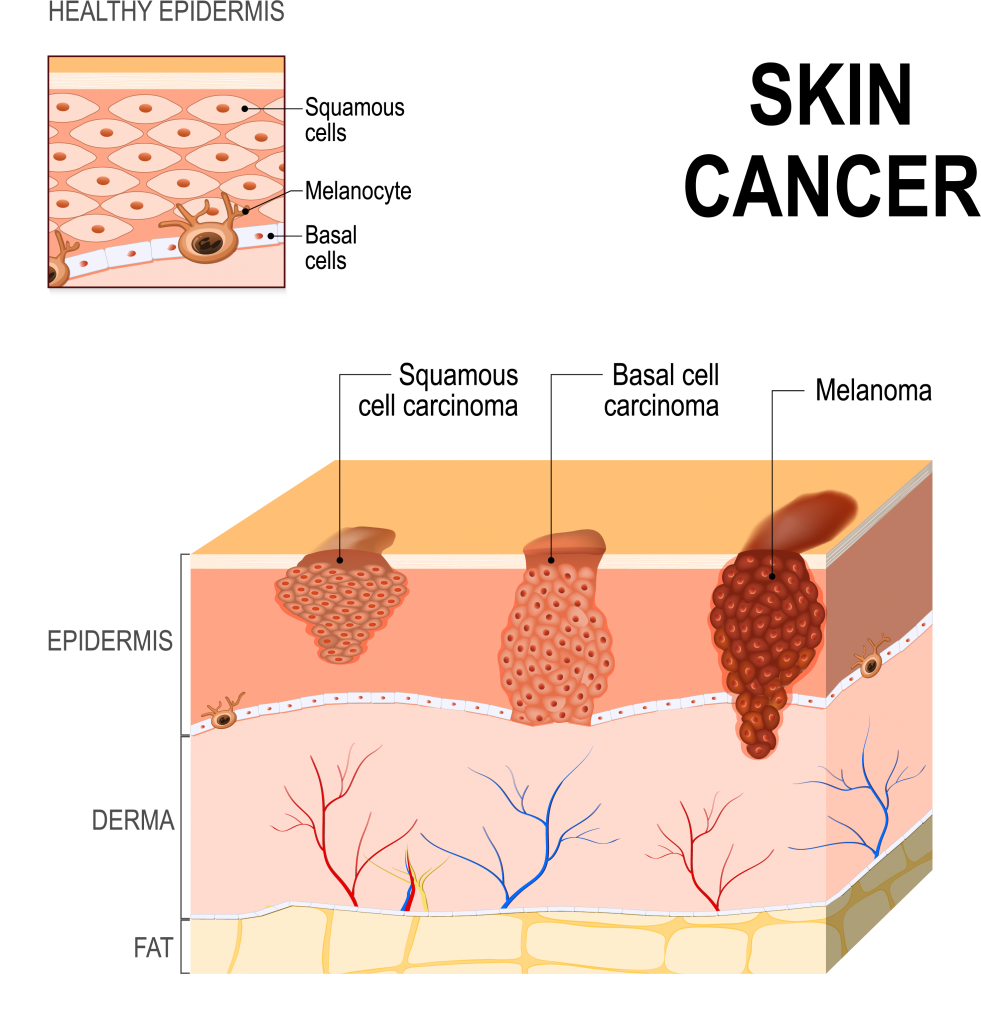
Many people know that skin cancer is the most common type of cancer. But did you know that there are different types of skin cancer? As the largest organ in the body, the skin is made up of lots of different types of cells, which can result in the development of different kinds of cancer.
It’s important to understand the differences because skin cancer type affects treatment options, progression and more. If you have been diagnosed with skin cancer, talk to your healthcare provider to better understand what type you have.
Basal and Squamous Cell Skin Cancer
- Most common types of skin cancer
- Basal cell starts in the lowest layer of the skin and squamous cell starts in the top layer of the skin
- Basal and squamous skin cancer can take on many different appearances:
- Scar-like areas that are flat, firm, pale or yellow
- Itchy, raised reddish patches
- Red patches that are rough or scaly and may crust or bleed
- Small, pink or red, shiny, pearly bumps – possibly with blue, brown or black areas
- Pink growths or lumps with raised edges and a lower center
- Oozing or crusted, open sores that don’t heal or heal then reappear
- Wart-like growths
- Learn more about how to spot skin cancer.
- Basal and squamous cell skin cancers do not spread to other parts of the body as frequently as other types of skin cancer
- Most basal and squamous cell skin cancers can be treated with surgery or other treatment that affects only the skin where the spot is located
- Learn more about basal and squamous cell skin cancer

Melanoma Skin Cancer
- Starts in skin cells called melanocytes, which produce the brown pigment, melanin, that makes skin brown or tan
- Can be more dangerous than basal and squamous cell skin cancer because it is more likely to spread to other parts of the body
- Usually indicated by a spot on the skin that has changed in size, shape, texture or color. Learn more about how to spot skin cancer.
- Healthcare provider will perform biopsy and other tests to determine whether the cancer has spread to other parts of the body and determine a stage
- Main treatments include: surgery, immunotherapy, targeted therapy, chemotherapy and radiation – your healthcare provider will work with you to determine the best type of treatment for your cancer
- Learn more about melanoma skin cancer
Merkel Cell Skin Cancer
- Starts in the Merkel cells of the skin, which are in the top layer of the skin very close to the nerves linked to the sense of touch
- Rare type of skin cancer
- Most early-stage Merkel cell skin cancer can be treated with surgery – the stage and type of your cancer, as well as your health condition will determine what kind of treatment is best for you
- Learn more about Merkel cell skin cancer
Lymphoma of the Skin
- Starts in the white blood cells in the skin
- Many different types of skin lymphoma – most common are mycosis fungoides and Sezary syndrome
- May appear as small pimples, raised or lowered flat areas, lumps or bumps under the skin affecting a small area or large areas of the skin
- Frequently start as a red or purple rash that is very itchy
- May coincide with other symptoms like fever, unintended weight loss or sweating
- Healthcare provider will perform biopsy and other tests to determine whether the cancer has spread and determine a stage
- Treatment for skin lymphomas fall into two main types: treating only the skin or treating the whole body – the stage and type of your cancer, as well as your health condition will determine what kind of treatment is best for you
- Learn more about lymphoma of the skin
Kaposi Sarcoma
- Starts in blood or lymph vessel lining
- Appears as brown, red or purple spots or tumors on or under the skin
- In the U.S., the most common type of Kaposi sarcoma is AIDS-related KS, which is found in those living with HIV
- Can be kept under control by treating the HIV when AIDS-related, or with local treatments, radiation or chemotherapy
- Learn more about Kaposi sarcoma
During your monthly self-exam, take note of any changes in the spots on your skin. If you notices any of the signs above, contact your healthcare provider.
Learn more about skin cancer prevention, symptoms and treatments.
Information obtained from the American Cancer Society.